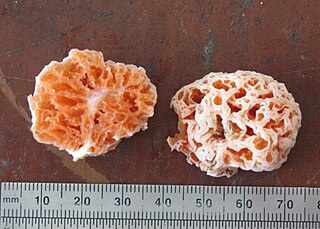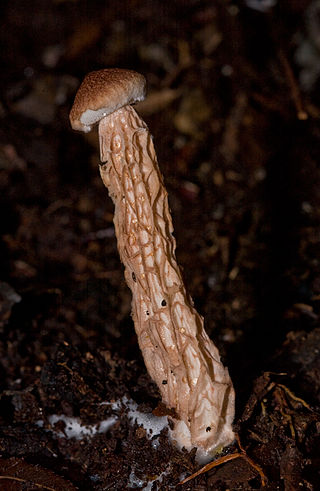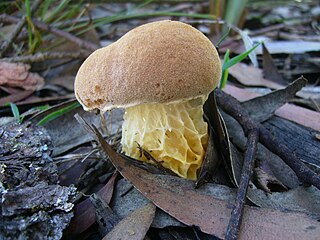Alphamenes is a small neotropical genus of potter wasps that currently contains 7 species, it was named by the Dutch entomologist Jacobus van der Vecht in 1977.

Maindroniidae is a very small family of silverfish, basal insects belonging to the order Zygentoma. It contains just a single genus, Maindronia, and a handful of species.

Austroboletus is a genus of fungi in the family Boletaceae. The widely distributed genus contains species that form mycorrhizal relationships with plants.

Boletellus is a genus of fungi in the family Boletaceae. The genus has a widespread distribution, especially in subtropical regions, and contains about 50 species. The genus was first described by American mycologist William Alphonso Murrill in 1909. The genus name means "small Boletus".

Hahncappsia is a genus of moths of the family Crambidae, and the order Lepidoptera.
Austrjapyx is a genus of diplurans in the family Japygidae.

Spongiforma is a genus of sponge-like fungi in the family Boletaceae. Newly described in 2009, the genus contains two species: S. thailandica and S. squarepantsii. The type species S. thailandica is known only from Khao Yai National Park in central Thailand, where it grows in soil in old-growth forests dominated by dipterocarp trees. The rubbery fruit bodies, which has a strong odour of coal-tar similar to Tricholoma sulphureum, consists of numerous internal cavities lined with spore-producing tissue. S. squarepantsii, described as new to science in 2011, is found in Malaysia. It produces sponge-like, rubbery orange fruit bodies with a fruity or musky odour. These fruit bodies will—like a sponge—resume their original shape if water is squeezed out. The origin of the specific name derives from its perceived resemblance to the cartoon character SpongeBob SquarePants. Apart from differences in distribution, S. squarepantsii differs from S. thailandica in its colour, odour, and spore structure.

The Boletineae are a suborder of the fungal order Boletales. Families in the Boletineae include the Boletaceae and the Paxillaceae.

Austroboletus gracilis is a species of bolete fungus in the family Boletaceae. Originally described as Boletus gracilis by Charles Horton Peck in 1872, it was transferred to the genus Austroboletus by Carl B. Wolfe in 1979.

Austroboletus rarus is a species of bolete fungus in the family Boletaceae. Found in Singapore and Australia, it was described as new to science by E.J.H. Corner in 1972, who called it Boletus rarus. Corner found the type collection growing on a forest floor in Bukit Timah in December 1940. He suggested that it might be a variety of Boletus rubiicolor. Egon Horak transferred it to the genus Austroboletus in 1980.

Austroboletus lacunosus is a bolete fungus native to Australia.

Austroboletus eburneus is a species of bolete fungus found in Australia. It was described as new to science in 1986. The species name eburneus is the Latin adjective "ivory-white".
Hahncappsia neotropicalis is a moth in the family Crambidae described by Hahn William Capps in 1967. It is found in Mexico (Xalapa), Guatemala, Costa Rica and Venezuela.
Thliptoceras neotropicalis is a moth in the family Crambidae. It was described by Schaus in 1912. It is found in Costa Rica.

Austroboletus subflavidus is a species of bolete fungus in the family Boletaceae. It is found in eastern North America, where it fruits near oak and pine trees. Originally described as a species of Tylopilus by American mycologist William Murrill in 1938, it was transferred to the genus Austroboletus by Carl B. Wolfe in 1980. The fruit body has a white to yellowish convex to flattened cap measuring 3–10 cm (1.2–3.9 in) in diameter. The pores on the cap underside, which measure about 1 mm wide, are initially white to grayish before becoming pinkish. The coarsely reticulate and pitted stipe measures 4.5–14.5 cm (1.8–5.7 in) long by 0.7–3 cm (0.3–1.2 in). The spore print is reddish brown; spores are spindle-shaped (fusoid) with dimensions of 15–20 by 6–9 μm.
Austroboletus mutabilis is a species of bolete fungus found in northern Australia. Described as new to science in 2006, it grows in dry sclerophyll woodlands. This bolete is characterised by its colour change—from deep red to orange and, finally, to yellow—that occurs in the cap. Almost no other Bolete goes through such a dramatic colour change as this species and this change may occur as a consequence of time, exposure to sunlight and/or local humidity.

Austroboletus occidentalis, commonly known as the ridge-stemmed bolete, is a species of bolete fungus found in Australia. It was described as new to science in 1986 by mycologists Roy Watling and Norma M. Gregory. The species name occidentalis is derived from the Latin occidens "west"..
Antonio Giordani Soika was an Italian entomologist, ecologist and director of the Civic Museum of Natural History of Venice. He had a long career in which he worked on various groups of insects but much of his work was on the Hymenoptera. He made great contributions to the knowledge of Neotropical wasps, especially potter wasps for which he produced many taxonomic keys and also monographs on the systematics of the wasp family Vespidae.
Austroboletus olivaceoglutinosus is a species of bolete fungus found in Sikkim in northeast India. It is so named for its sticky olive-green cap.











